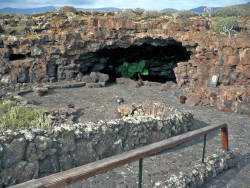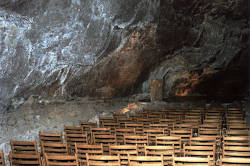Cueva de Los Verdes
Cave of Los Verdes
Useful Information


| Location: |
LZ-204, 35542 Haría.
Lanzarote, Canarias. North-east side of the island, along LZ-1. (29.160482, -13.439370) |
| Open: |
All year daily 9:30-16:15. Online booking mandatory. [2025] |
| Fee: |
Adults EUR 16, Children (7-12) EUR 8, Children (0-6) free, Diasbled EUR 11.20. Canary Island Resident: Adults EUR 12.50, Children (7-12) EUR 6.25, Children (0-6) free, Disabled EUR 9. Lanzarote Resident: Adults EUR 2. [2025] |
| Classification: |
 Lava Tube Lava Tube
|
| Light: |
 Electric Light Electric Light
 Coloured Light Coloured Light
|
| Dimension: | L=6,100 m, VR=300 m. |
| Guided tours: | D=50 min, L=2,000 m. |
| Photography: | allowed |
| Accessibility: | no |
| Bibliography: | D=40 min. |
| Address: | Cueva de Los Verdes, Lanzarote, Tel: 34-928-848-484. |
| As far as we know this information was accurate when it was published (see years in brackets), but may have changed since then. Please check rates and details directly with the companies in question if you need more recent info. |
|
History
| 1964 | developed and opened to the public by Jesus Soto. |
Description


The Cueva de Los Verdes (Cave of Los Verdes) is a lava tube which was formed by a lava flow from the erupting volcano Montaña Corona about 3,000 t0 4,000 years ago. The lava flow crossed the Malpaís de la Corona to the sea, a distance of about six kilometers. Malpaís is a Spanish word describing this kind of arid, volcanic landscape, which may be translated badlands. The cave has some 20 openings to the surface which are called Jameos. They were formed by roof collapses, have generally an elliptic form when a longer section of the cave collapsed. The debris of the roof often forms ramps which allow rather easy descent into the cave.
Verdes is the Spanisch word for the colour green, but the cave was named after someone with the family name Verdes, who either discovered or lived in the cave, both stories are told. So the translation Cave of The Greens are actually nonsense.
With a length of more than 6 km, this cave was the longest lava tube in the world for a long time, until the mid-20th century.
It was then outrun by a number of much longer lava tubes, and today the
 Kazumura Cave
on Hawai’i with a length of 65,500 m [2010] is the longest known lava tube in the world.
Still, this outdated superlative, which is definitely more than half a century gone, is rewritten and found even in recent literature.
Kazumura Cave
on Hawai’i with a length of 65,500 m [2010] is the longest known lava tube in the world.
Still, this outdated superlative, which is definitely more than half a century gone, is rewritten and found even in recent literature.
According to legend, the inhabitants of Lanzarote used the cave to hide from pirates and slave traders here. It seems the native Guanches hid here from the Spanish invaders. Then again the locals hid during the 17th century when the islands were raided numerous times. We read the comment that the cave became a deadly trap for invaders, but could not find any more detailed explanation, so we must interpret this as an legend.
The cave was developed as a show cave in the early 1960s by César Manriques, and opened to the public in 1964. His friend Jesús Soto created a very sophisticated and artistic electric light system. The fact that throughout the cave Gregorian Chants are played is rather disturbing. One wider part of the passage has been turned into a concert hall with a perfect acoustics seating 300 people. It is not used very often, as the cave lacks rather basic amenities like toilets.
One of the highlights and probably the most intensively photographed part of the cave is filled with a sweet water lake. The cave lake reflects the walls and ceilings, and the fantastic light makes this an impressive sight. Of particular interest for biologists is the Langostino Blanco, a troglobiont lobster of white color which is perfectly adapted to the conditions of life in those caves. This species is endemic, which means that it exists exclusively here!
- See also
 Search DuckDuckGo for "Cueva de Los Verdes"
Search DuckDuckGo for "Cueva de Los Verdes" Google Earth Placemark
Google Earth Placemark OpenStreetMap
OpenStreetMap Cueva de los Verdes - Wikipedia (visited: 06-AUG-2014)
Cueva de los Verdes - Wikipedia (visited: 06-AUG-2014) Cueva de Los Verdes, official website (visited: 15-NOV-2023)
Cueva de Los Verdes, official website (visited: 15-NOV-2023) Cueva de los Verdes (visited: 15-NOV-2023)
Cueva de los Verdes (visited: 15-NOV-2023) Cueva de los Verdes Lanzarote, gallery (visited: 15-NOV-2023)
Cueva de los Verdes Lanzarote, gallery (visited: 15-NOV-2023)
 Index
Index Topics
Topics Hierarchical
Hierarchical Countries
Countries Maps
Maps